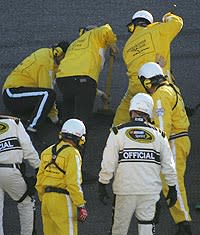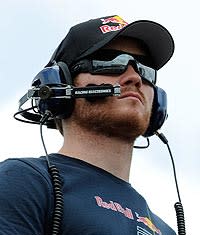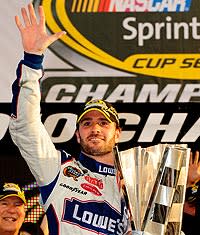NASCAR in 2010: Boys, have at it
The tagline for NASCAR's 2010 Sprint Cup season was written before the first green flag even dropped: Boys, have at it.
The message couldn't have been clearer. In an effort to reinvigorate the kind of politically incorrect personalities that had endeared NASCAR to the masses, the gents in the corner offices were, in essence, telling the drivers they would be looking the other way in 2010.
With the shackles off, indeed the boys had it at. They fought (see Jeff Gordon and Jeff Burton), they feuded (see Kyle Busch and Brad Keselowski) and they wrecked each other (see Carl Edwards and Keselowski).
In the end, the result was the same – Jimmie Johnson remained king of the mountain for an unprecedented fifth straight year.
Top stories of 2010
10. The Daytona 500: Pothole Edition
Six hours &ndash that's how long it took to complete 2010 Daytona 500. That's because 123 laps into NASCAR's marquee race, a pothole opened up between Turns 1 and 2. The hole took more than two hours to repair, and the fix only lasted 38 laps before opening up again, leading to an additional 40-minute delay.
"This is the Daytona 500," then track president Robin Braig said. "This is not supposed to happen."
But it did, and Braig is no longer working for Daytona International Speedway. The pothole may or may not have been the reason for his departure, but NASCAR clearly kicked off its season with egg on its face. It's one thing for a wreck to red flag a race, another to have a hole hold things up with 13 million people watching.
Those who stuck it out got to see a fantastic finish, with Jamie McMurray – out of a job just a few months earlier – holding off a hard-charging Dale Earnhardt Jr. It was a thrilling end, with a screaming Junior Nation rising as one, but in the end the biggest race of the season will be remembered for a 15-inch pothole.
9. Danica's inauspicious debut
When Danica Patrick arrived at Daytona in February, interest surrounding her NASCAR experiment was at a fever pitch. Nine months and 13 fair-to-middling races later, the fever had broken.
No, not all the shine had been removed from Danica's luster, but she certainly wasn't living up to the hype. Not that it was her fault. She didn't create the fury, nor did she waltz into the NASCAR world with her chest puffed out declaring she was going to show the good ol' boys how to race.
In fact, her attitude was quite the opposite. From start (a fiery crash at Daytona) to finish (19th place at Homestead-Miami, her best result of the season), Danica was deferential, sincere and humble. Through her struggles and her honest assessment of them, she may have actually won over some fans.
Still, it's hard to get the masses excited when you're running in the mid-20s.
Patrick did show improvement – she qualified fifth for the season finale and actually led four laps, albeit under caution – and summed up her season this way: "This has been an up-and-down year. It's been a character-building year, a humbling year. I did know coming into this season that it was going to be the hardest year I have ever had.
"Still nothing can really prepare you for the hardest year you have ever had. It sucks at times. It's still challenging. But I've learned a lot. I've learned to see the good in what seems to be a bad weekend, or at least to me anyway. People are always trying to remind me there were good weekends, but unless I have a good result, I don't feel like that."
Patrick will run a similar 13-race Nationwide schedule in 2011, including the first four races of the season.
8. Brian Vickers season, career put on hold
Coming off his first career berth in the Chase, Brian Vickers expected big things in 2010. But in May, just 11 races into the season, racing took a back seat.
Vickers had been experiencing pain in his left side for about a week. He didn't think much of it and went about his business. But while visiting Washington D.C., the pain increased so much that it finally forced Vickers to Walter Reed Hospital.
There doctors discovered that blood clots had formed in Vickers' lungs and left leg.
The situation was very serious. Not only would Vickers not race again in 2010, but his career was put on hold indefinitely.
"I can actually race on blood thinners, I just can't crash," he explained in an interview 10 days after the blood clots were discovered. "So I told them if I promise I won't crash, will they let me race?"
The answer, of course, was no, and Red Bull Racing immediately announced that Casey Mears would fill in for Vickers.
Tests eventually found that Vickers had a hole between the right and left atrium in his heart. Doctors also found that he suffers from May-Thurner Syndrome, a condition that puts him at risk of blood clots. On July 12, Vickers had surgery to repair the hole in his heart.
A month later, Vickers announced that doctors had cleared him to race again in 2011.
"I will be back next season racing in January," he said. "I'm really excited about that. I had two issues I never knew about fixed. It's a bit of fresh air for me to really kind of know part of what caused this."
7. Richard Petty nearly closes shop
For several days in late October, it appeared that Richard Petty Motorsports might not finish the season. Controlling partner George Gillett had fallen on hard times financially due to the sale of Liverpool soccer club, and as a result RPM had fallen behind on some of its payments.
There were some questions about whether RPM would be in Talladega to race on Oct. 31. They were. A week later, vice president of competition Robbie Loomis announced that RPM had received enough financial backing to finish the season.
A week after the 2010 season ended, Petty announced he and a group of investors had purchased RPM from Gillett and will race as a two-car team in 2011.
For Petty, this marked just the latest step in what's been a tumultuous three years for NASCAR's unquestioned king. In 2008, Petty sold part of his organization to an East Coast investment group. That partnership lasted just six months before Petty Enterprises merged with Gillett Evernham Motorsports to form the newly branded Richard Petty Motorsports.
Now, as RPM enters 2011, Petty is back in control. He will lead the partnership with Medallion Financial Group and DGP Investments.
6. Hendrick shakes up organization
By the end of 2010, with three of his four drivers finishing the season winless, Rick Hendrick had seen enough. Change was necessary.
Two days after his fourth driver, Jimmie Johnson, won title No. 5, Hendrick made the bold move to uproot Jeff Gordon, Mark Martin and Dale Earnhardt Jr., moving all three to different teams. Gordon joined Martin's former team led by Alan Gustafson, Martin switched to Earnhardt's led by Lance McGrew and Earnhardt took Gordon's place with Steve Letarte atop the pit box.
"We need to be better across the board," Hendrick explained.
The question now is will they be better?
The shakeup results in a new-look Hendrick Motorsports for 2011. Earnhardt will share a garage with Johnson, while Gordon and Martin are now aligned in the 5/24 garage.
Hendrick insists the change isn't all about Earnhardt, who finished 21st in the standings. After finishing first (Johnson), second (Martin) and third (Gordon) in 2009, only Johnson was a championship contender this season. Neither Earnhardt nor Martin made the Chase, and Gordon was never a factor.
Still, the intrigue surrounding Earnhardt will be even greater than usual going into next season. Junior is now parked in the same garage as Chad Knaus, the crew chief extraordinaire who helped Johnson win five straight titles. For years Junior Nation has wondered how its driver would do paired with Knaus. Although Earnhardt and Knaus won't be working directly together, this is as close as it's going to get for Junior.
Will it work?
5. Bowyer wins, then loses
NASCAR had a way in 2010 of kicking off its biggest events with a thud. The Daytona 500 had the pothole. The Chase had Bowyer-gate.
Bowyer may have been the last driver to qualify for the 2010 Chase, but when he went to New Hampshire and won the opening race of NASCAR's playoff, he looked to be a real threat for the title.
For three days anyway.
On the Wednesday following Bowyer's win, NASCAR determined that his car failed post-race inspection. The rear of his car was found to be 130-thousandths of an inch too high. Small measurement, big consequence.
NASCAR slapped Bowyer with a 150-point penalty that dropped him from second in the standings all the way to 12th, effectively slamming the door shut on any hope he had of racing for the title.
Determined to go down fighting, Richard Childress Racing launched a protest that involved a crash expert and more than four hours of testimony. None of that mattered, though. The appeal panel found in favor of NASCAR, and Bowyer, who would have finished fifth in the standings if not for the penalty, wound up 10th.
4. Harvick, RCR are back
Kevin Harvick didn't make the Chase in 2009. He finished the 2010 regular season as the points leader and nearly won the title.
It was quite the turnaround for Harvick and Richard Childress Racing as a whole. In one year, RCR went from a pretender to a top-tier team ready to challenge Hendrick Motorsports and Joe Gibbs Racing.
Harvick led the revival. Having gone winless since the 2007 Daytona 500, Harvick drove to victory lane three times in 2010, led the points standings for 20 of the first 26 weeks and wound up with 26 top-10 finishes – three more than any other driver.
While Harvick didn't bring home the championship – he ultimately finished third, just 41 points out of first – the future looks bright for him and RCR. That's a good thing for NASCAR, because the sport now has four teams (Hendrick, Gibbs, RCR and Roush Fenway) which can legitimately challenge for a title.
3. Hamlin tears his ACL, then nearly wins the title
Prior to the season, Denny Hamlin became the latest "it" driver predicted to dethrone Jimmie Johnson. Hamlin earned that distinction after winning a career-best four races in 2009, including two of the last five.
But all thoughts of Hamlin winning anything were put on hold when he announced he'd torn his ACL playing basketball in January.
Initially, Hamlin opted to put off surgery until the end of the season. But when the injury became too much, he decided to have the procedure done during an off-week in late March.
Ten days after surgery, Hamlin was in his car at Phoenix, where, limping around on one leg, he stunk up the joint – finishing 30th.
Just seven races into the season, the question went from, "Could Hamlin beat Johnson?" to "Could Hamlin even make the Chase?" He'd dropped to 18th in the standings, and no one knew how long his road to recovery would last.
Hamlin answered that question the very next week when he won at Texas, reinserting himself as not only a contender, but also a serious threat.
"I did it for September," Hamlin said of his decision to go ahead with reconstructive surgery instead of putting it off until the end of the season. "I knew come Chase time if I was lucky enough to be in that top 12, it would make me more prepared to make that championship run."
And he was ready, winning a series-high eight races. He even held the points lead going into the final race of the season. But then …
2. Johnson completes his drive for five
Not once in his four-year reign had Jimmie Johnson gone into the season finale with anything less than a 63-point lead. In 2010, Johnson headed to South Florida trailing Hamlin by 15.
It certainly wasn't an insurmountable deficit, but a daunting one nonetheless considering Hamlin was the defending race winner at Homestead-Miami Speedway and all season long had been better than Johnson on mile-and-a-half tracks.
Knowing the one advantage he had was experience, Johnson went about playing that card over and over and over in the days leading up to the finale. Sitting next to Hamlin in a pre-race press conference, Johnson declared he had nothing on the line – that the title was Hamlin's to lose. Johnson openly wondered how nervous Hamlin would be and if Hamlin was losing sleep.
Through it all, Hamlin remained outwardly calm, at one point wondering who was in whose head if Johnson kept talking about him.
It was a fair point. But unfortunately for Hamlin, Johnson was right all along. Experience did matter.
Johnson qualified well; Hamlin didn't. Johnson kept out of trouble; Hamlin spun early. Johnson didn't panic when his team came up short on pit road; Hamlin and crew chief Mike Ford couldn't decide when to fix the damage caused by the early spin.
When the checkered flag flew, Johnson was in second – equaling his best-ever finish at Homestead-Miami Speedway. Hamlin came home 14th – his worst finish at Homestead since his rookie year.
The difference in payout was 54 points. Johnson had won his fifth straight title with room to spare.
1. "Boys, have at it"
Who would have thought four words – 12 letters – would lead to this.
With all due respect to Johnson and his accomplishment, nothing symbolized the 2010 season more than Robin Pemberton's message way back in January when he declared NASCAR was putting some of the policing of the sport back in the drivers' hands.
The theme – "Boys, have at it" – was evident from the beginning of the season, when Carl Edwards exacted revenge on Brad Keselowski, right through the end when Jeff Gordon went after Jeff Burton.
It led to Kurt Busch wrecking Gordon, Keselowski calling Kyle Busch an "ass" to 160,000 at Bristol and David Reutimann retaliating against Kyle Busch.
As long as the ire wasn't directed at them, NASCAR was fine with it. And when it was, they stepped in, and stepped in again.
Did "boys, have at it" have an impact on the season? Certainly. Kyle Busch's title hopes were dashed when Reutimann wrecked him. So were Gordon's when Kurt Busch wrecked him.
But if nothing else, "boys, have at it" served its purpose, with one comment from Joey Logano: "I don't know what [Kevin Harvick's] deal is with me. It's probably not his fault. His wife wears the firesuit in the family."




